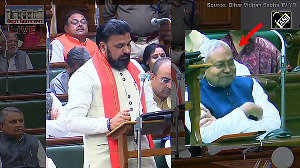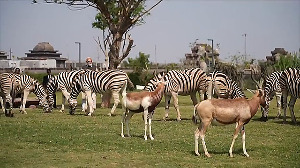The India Meteorological Department sees the chances of a recurrence of drought this year as slim.
IMD director-general RR Kelkar said that the new statistical model used for predicting drought was fairly reliable and it had projected only a 21 per cent probability of a drought this year.
"This, in fact, means there is a 79 per cent chance that it will not be a drought year," he said.
While the earlier monsoon forecasting model was incapable of distinguishing between drought and no-drought situations, one of the four new models being used this year is tuned to predicting the probability of drought.
This model can estimate up to 90 per cent probability of drought. The 21 per cent drought probability for this year is, therefore, quite low.
Besides, there have been only three occasions of consecutive droughts in the past 100 years. These were 1904-1905, 1965-1966 and 1986-1987.
This apart, the El Nino (the warming of the Pacific Ocean), which played havoc with weather patterns last year, is now neutral. Whether it gives way to La Nina (the opposite of El Nino) will be known only by the end of June.
"If La Nina emerges, it will definitely have a positive impact on the monsoon. Past record shows that while El Nino may be good or bad for the monsoon, La Nina has invariably been good for it," Kelkar pointed out.
He also indicated that the IMD might issue a separate forecast for the agriculturally crucial month of July in the beginning of that month instead of mid-July as announced earlier. Last year, around 50 per cent of the paucity of precipitation in July led to the drought.
Kelkar said the IMD had to change its monsoon prediction model because it had 16 parameters, many of which had, over the years, lost relevance. The new models are based on 10 parameters.
"The relevant data for eight of the 10 parameters is available by March-end, allowing the IMD to make its long-term prediction as early as mid-April, against end-May earlier," he said.
Kelkar, however, pointed out statistical models had inherent shortcomings and would ultimately have to be replaced by the relatively more precise dynamic models.
Even the new statistical models cannot predict the onset of the monsoon, its performance in different meteorological sub-divisions or the paths the depressions will move along.
Many global weather monitoring and forecasting agencies use dynamic models. Statistical models rely heavily on atmospheric factors, which change dramatically in short periods. Dynamic models, on the other hand, are based on relatively stable factors, making the projections more dependable.
"However, the predictions made by other global weather agencies are not India-specific and, therefore, of little use to us. They only predict the anomalies in likely rainfall and not the mean monsoon flows (precipitation). Anomalies cannot be trusted," Kelkar said and added that India would have to develop its own dynamic model to ensure better monsoon forecasting. Such a model should be available in a few years, he said.






 © 2025
© 2025